Annual Weather Chart for Cuenca, Ecuador ("Spring-Like" Climate?)
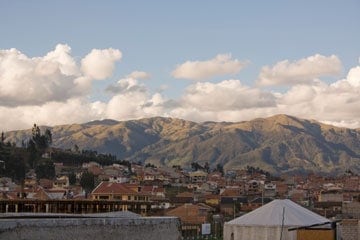
On an almost daily basis, we get asked:
- When is the rainy season in Cuenca?
- What is the best time to visit?
- When is it hottest in Cuenca?
These are some of the most common questions from travelers and prospective expats. And it is understandable – it’s important to know how to plan for a visit. Even more so if you are thinking about living here.
To help answer those questions, we researched and are publishing the monthly/annual averages for Cuenca: highs, lows and precipitation. Charts are divided by imperial and metric measurements.
Annual Climate Chart for Cuenca, Ecuador (Fahrenheit / Inches)
| Climate data for Cuenca, Ecuador | |||||||||||||
|---|---|---|---|---|---|---|---|---|---|---|---|---|---|
| Month | Jan | Feb | Mar | Apr | May | Jun | Jul | Aug | Sep | Oct | Nov | Dec | Annual |
| Avg high °F | 69 | 70 | 69 | 69 | 67 | 66 | 65 | 66 | 69 | 70 | 71 | 71 | 68.5 |
| Avg low °F | 50 | 51 | 51 | 50 | 49 | 47 | 47 | 46 | 48 | 49 | 46 | 49 | 48.6 |
| Precipitation inches | 2 | 1.8 | 3.2 | 4.3 | 4.3 | 1.7 | 0.9 | 1.1 | 1.6 | 3.1 | 1.8 | 2.5 | 28.3 |
Annual Climate Chart for Cuenca, Ecuador (Celsius / Centimeters)
| Climate data for Cuenca, Ecuador | |||||||||||||
|---|---|---|---|---|---|---|---|---|---|---|---|---|---|
| Month | Jan | Feb | Mar | Apr | May | Jun | Jul | Aug | Sep | Oct | Nov | Dec | Annual |
| Avg high °C | 21 | 21 | 21 | 21 | 19 | 19 | 18 | 19 | 21 | 21 | 22 | 22 | 20.4 |
| Avg low °C | 10 | 11 | 11 | 10 | 9 | 8 | 8 | 8 | 9 | 9 | 8 | 9 | 9.2 |
| Precipitation cm | 5 | 4.6 | 8.1 | 10.9 | 10.9 | 4.3 | 2.3 | 2.8 | 4.1 | 7.9 | 4.6 | 6.4 | 71.9 |
Data primarily based on charts from Weatherbase.com
What do we learn from the charts?
First of all, the temperature seldom changes, month by month. There is a variation of just a couple of degrees.
What is significant is how much the temperature changes during one day. Some days will go from just a few degrees above freezing to more than 25°C by midday. This dramatic temperature change can make travelers (and expats) sick.
So, is it cold in Cuenca? Yes, sometimes it even hails. But this is rare. It is usually similar to a Canadian spring-like climate.
It Doesn’t Rain Like We’re Used To
Sometimes, it rains a lot. I’m not sure if the flooding is because of poor drainage or just because of the volume of water that falls in such a short period of time.
But as you will see in the following photos, sometimes it rains hard in Cuenca. These photos are from a few years ago, taken in the month of February – all from the same rain storm.
My favorite one is of the water coming up out of the gutter. Some of the gutters were actually pushing water more than a meter in the air (sorry, no photo of that).
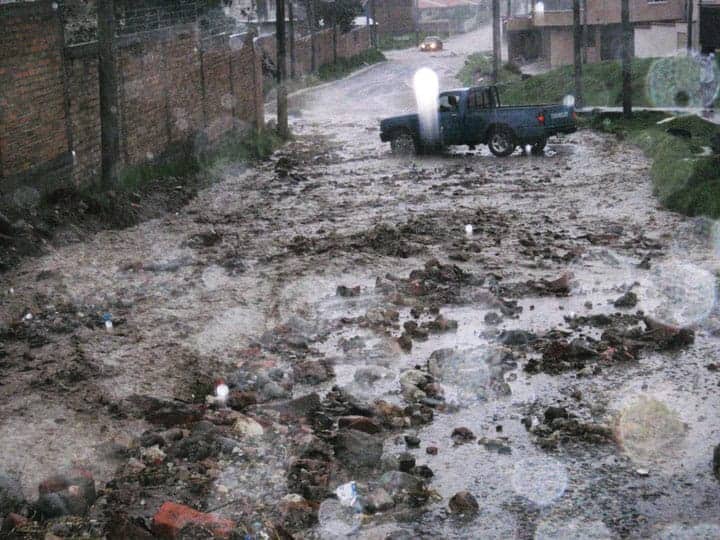
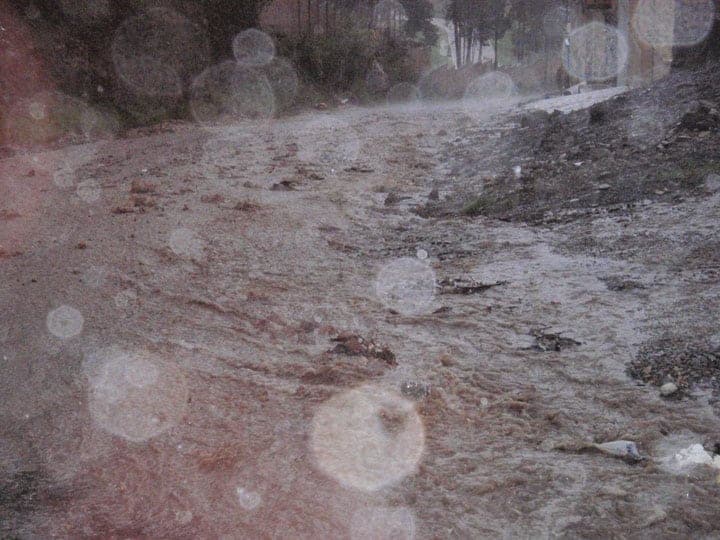

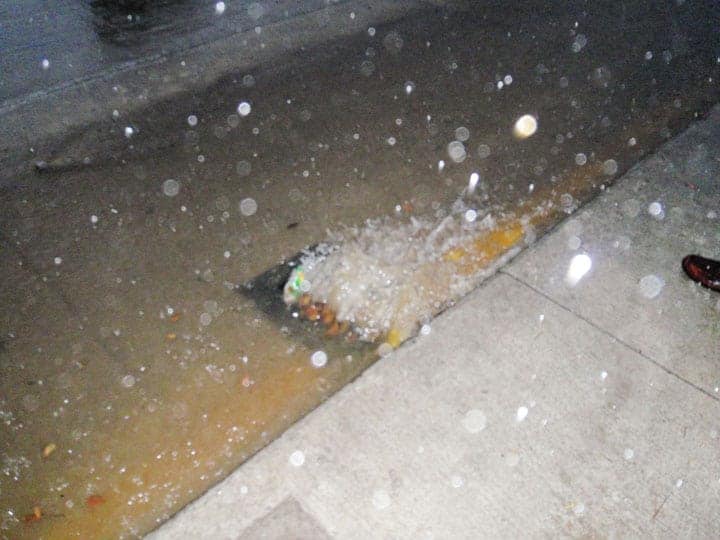
What do you think? Do you enjoy a good rainstorm?
Is it cold in Cuenca Ecuador?
Sometimes it’s cold in Cuenca.
It never snows in Cuenca, but sometimes it hails (tiny ice balls which melt when they hit the ground).
When it’s overcast and damp it gets chilly. I find myself shivering on days like that, but generally all I need to feel comfortable is a jacket, a pair of gloves and a light scarf. When the sun comes out it warms up fast, and off come the scarf, gloves and usually the jacket as well.
I would describe most days in Cuenca as warm, moderate or cool, usually all three in the same day! Cold days are not the norm.
Acclimatization
When we first moved to Cuenca we saw warm gloves, hats and scarves being sold at the local market. This seemed odd to us because we didn’t see the need for these things when we arrived. Our view began to change as we started to acclimatize.
When friends come to visit us they find it funny that we dress more warmly than they do. But the reason for this is that we are acclimatized and they are not. The friends that visit us are from Canada, Cuenca is warmer than Canada for the majority of the year.
We are not accustomed to the cold fall and winter in Canada anymore, so the cool overcast days we experience in Cuenca seem colder to us now than they did when we arrived.
If someone is visiting from somewhere that’s warm most of the time (like Florida or California) they might find Cuenca a little chillier than they had expected. They may have a different experience than that of our friends visiting from Canada; they might be surprised to see people dressed in lighter clothing than they would be comfortable wearing.
As we became acclimatized from a cooler climate perspective, I can assume that they would acclimatize from a warmer climate perspective. And with time they may not find it as cold as they did when first they first arrived.
With a surprise rainstorm just around every corner, don’t forget to bring your umbrella. Need a good one? Here are some of the best travel umbrellas.
Four Seasons in One Day in Cuenca
“Cuenca, where there are four seasons in one day!” This is a joke we often hear from people living in Cuenca.
The changing climate is the reason that on any given day during a walk through downtown Cuenca, you may see someone in a down-filled jacket, followed by someone in flip-flops and a tank top.
The guy in the down-filled jacket may live up in the hills around the city, and might have left his house first thing in the morning when it was damp and chilly.
The girl in the flip-flops may live right down town, and might have left her apartment after lunch when the sun was warm and strong.
The changes in climate have to do with the altitude, and the proximity to the equator. Because of the altitude, it can get cool quickly when the sky becomes cloudy.
And because of how close Cuenca is to the equator, the sun can feel very strong when the sky is clear. This is why people are often seen holding papers, a book, a scarf or whatever they may have on hand over the side of their head that’s receiving the direct sunlight.
If it’s chilly and overcast in the morning, the afternoon could be sunny and very warm. The reverse is true as well, so I find it important to carry a bag big enough for my gloves, scarf and umbrella if I’m going to be exploring for any amount of time. A hat is also a good idea during the late morning/early afternoon, for protection against the strong sun.
A House or an Apartment?
The majority of buildings in Cuenca are made out of concrete. It never really warms up inside the concrete homes because the nights are always cool in Cuenca. A stand alone home will be cooler inside than an apartment in an apartment building, because of the insulating nature of the surrounding apartments.
When I’m inside I usually wear a sweater, and when I step outside I’m often surprised at the difference in temperature. When the sun is shining I quickly become too warm in my sweater, and find a t-shirt to be just right.
The difference in the inside temperature between a house or an apartment may be why some people buy electric heaters and lots of warm blankets, while others don’t really see the need for them. The location of the house may make a difference as well; because of the difference in elevation, it’s slightly warmer in the city than it is in the surrounding mountains. Some people also just have a more active internal furnace than others.
The Perfect Climate?
There is a lot to be said for Cuenca’s “Spring Like” climate. And the term “Spring Like” can mean different things to different people, depending on where they are from. My favorite time of the year in Canada is the spring; a sunny spring day is hard to top in my eyes.
So a sunny day in Cuenca is just about perfection for me.
The sunshine of a “Spring Like” day playing off of the colonial architecture in Cuenca definitely makes for one of my most favorite places. Days like that make the overcast/cool/cold days bearable. Cuenca has great weather but it isn’t the Caribbean.
What to Expect in Cuenca: Cold Apartments?
The area of Cuenca has the reputation of enjoying spring-like weather all year round. With that idyllic climate in mind, some expats are initially shocked at the cool temps we often experience here in Cuenca.
At night during the months of June to September, the temperatures can drop to the mid-30s (Fahrenheit). If the day is cloudy or windy, the temps will sometimes remain in the mid-50s all day long. Adding to the cool weather shock factor is the fact that houses here in Ecuador often do not have any type of heating system installed. We often have to wear jackets and long pants in our house to keep warm, even during the day.
What happened to the spring-like weather in Cuenca? It does exist and we often enjoy beautiful sunny days with the temperatures rising to the mid-70s. However, the reality is that the weather in Cuenca can change at the drop of a hat, and what starts out to be a sunny day can turn into a cold, rainy evening.
During the rainy season, it is not unusual to experience overcast, rainy conditions for days at a time. So, if you are planning to move to the mountains of Ecuador, it is good to come here with the knowledge that the weather is not always spring-like.
Here is Drew’s perspective (our 12-year-old) on the weather in Cuenca:
Crazy Weather in Cuenca, Ecuador
Here in Cuenca the weather is crazy! There is a saying about it: “if it’s sunny in the morning, it surely will rain in the afternoon”.
And boy is that true! The sunnier it is in the morning, the rainier it will be in the afternoon.
Sometimes we will hear thunder and see lighting out of the corner of our eye. But then, when we go over to the window, one side is as bright as the nicest day of summer. And the other side is dark as night.
The weather changes make it very hard to plan a day at the park. You can’t just watch the news and see the forecast. There is no way to predict it. But something that we like to do is if we have plans with friends to go to the park and it doesn’t work out because it’s raining, we just go over to our house and play games. Why let a rainy day ruin the fun?
So that’s the forecast – thanks for reading! But sometimes it works to go to the park. I hope that if you get to come to Cuenca, this will be your case.
Well, that’s just a weather update! I hope you liked it. ~ Drew Haines
Hail and Lightning Storm in Cuenca, Ecuador (Video of Granizo)
Today started off like a typical day in Cuenca – sunny. Early this afternoon, the clouds darkened and it started to rain – which is also fairly typical. We noticed some small ice pellets in the rain – very small, but visible on the windows of our house.
Very quickly the pellets got larger and they began to accumulate. So Dena grabbed her camera and filmed this short video. While hail isn’t unheard of, it isn’t very common. This is the biggest hail storm we’ve seen since we’ve been here.
The pellets only lasted about 15 minutes before they began to melt. The storm continued – thunder, lightning and lots of rain. Now, it has cleared and things are beginning to dry off. The force of the hail was strong enough to lift some of the concrete on the window ledge. Kind of like a wet sandblaster.
Interested to learn more about the weather across the country? Check out our Guide to Ecuador Weather: Climate Charts for all 4 Regions
What is the most unexpected weather you’ve seen while traveling or living abroad? Join me in the comments!
In the coming weeks, I’ll be preparing climate charts for the top travel/expat areas within the country. If you have a great weather resource, please share it in the comment section below.
Cuenca Ecuador is famous for it’s “spring-like” climate. Warm days and cool nights. But what does it really mean? What can you expect on your trip?
What is a “Spring-Like” Climate in Cuenca?
In our news series: What’s Your Question About Cuenca, Ecuador? Lionel Riley asks:
We all hear about Cuenca’s spring-like weather and houses with no ac/heating. I’ve been looking at the nighttime temperatures and they seem to average in the mid-forties. I live in the San Francisco Bay area and temperatures in the mid-forties at night is cold. How does one call this spring-like weather?
A few months ago, we discussed What is a “Spring-Like” Climate? but we will try to clarify it somewhat.
“Spring-like” According to What Standard?
Lionel makes a good point. Spring in the San Francisco Bay area is a little different than a New York spring and even more different than a Northern Ontario (Canada) spring. The term is very subjective.
When we refer to “spring-like” here in Cuenca, we are talking from our perspective. We are Canadians and spring in our home province of Nova Scotia is a perfect time of year. Its warm in the day (t-shirt weather – yet another subjective term) and cool (sweater weather) in the evenings.
Cuenca is like this. The sun is hot in the day and it cools off significantly at night. It rains a fair amount – often without much warning.
If you are from Southern California you might find the evenings cooler than you are used to. The sun is different than the southern States. Although it doesn’t get that “hot” it feels very hot because of the strength of the sun here on the equator.
So if you are coming to visit, you’ll want more than sandals and shorts. A long sleeve t-shirt and rain jacket are also in order. Oh – and shorts aren’t a very common sight here. Light pants might help you fit in a bit better.
Curious about the spring-like climate in Cuenca? I’ll do my best to explain it.
There seems to be some confusion online about what the expression “spring-like” actually means. Is it icy cold? Or is it beach weather? Just what does spring-like mean?
Does Cuenca Really Have a “Spring-Like” Climate?
Imagine the Northern US / Southern Canada in the months of May/June. But for 12 months of the year.
In the months of May and June, you’ll see lots of rain, lots of sun. Evenings are cool, days are pleasant and occasionally hot. On overcast days, you’ll need a sweater or a shell jacket.
What it doesn’t mean:
- Snow, ice and frostbite
- Heatstroke and 40 degrees (Celsius) or 100 degrees (Fahrenheit)
- Air conditioners or furnaces
What it does mean:
- It will rain
- It will be sunny and warm
- Some days it will be hot
- The evenings can get cool – especially on clear nights.
If you are thinking about visiting the Andes, and specifically the city of Cuenca, you might wonder what you’ll need.
First, here’s what you won’t need on your trip to Cuenca:
- A snow shovel
- Skis or crampons
- Igloo architectural plans
- Short shorts (yeah, they can stay at home, even if you’re going to the coast. No one likes those . . .)
What you will need:
- sunscreen and hat (the sun is strong here)
- raincoat and sweaters
- warm jammies – (I’m told)
- portable umbrella
The cool rainy season is May to August. It is warm and dry the rest of the year. Of course, it can be rainy any time of year. It just rains more in the rainy season – imagine that!
Learn more about Cuenca, Ecuador.
Storm Clouds of Cuenca, Ecuador
This shot was taken with our daughter’s little point-and-shoot camera. We were just heading into downtown when storm clouds formed overhead. The sun was still shining on the white of the church making a pretty outstanding contrast.
Rainstorms can roll in pretty quick in Cuenca. For this reason, most people carry an umbrella.
Interested to learn more about the weather across the country? Check out our Guide to Ecuador Weather: Climate Charts for all 4 Regions

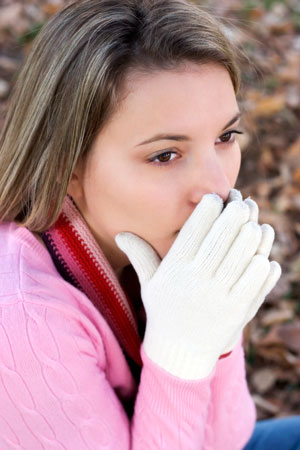

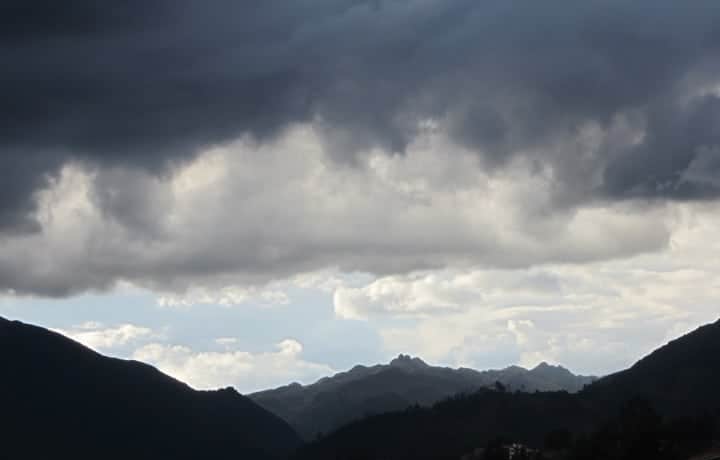
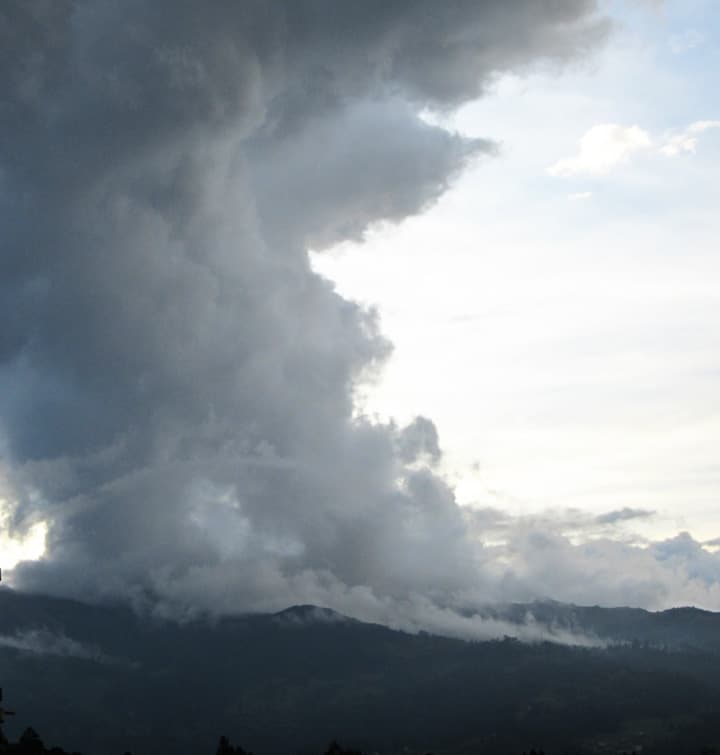
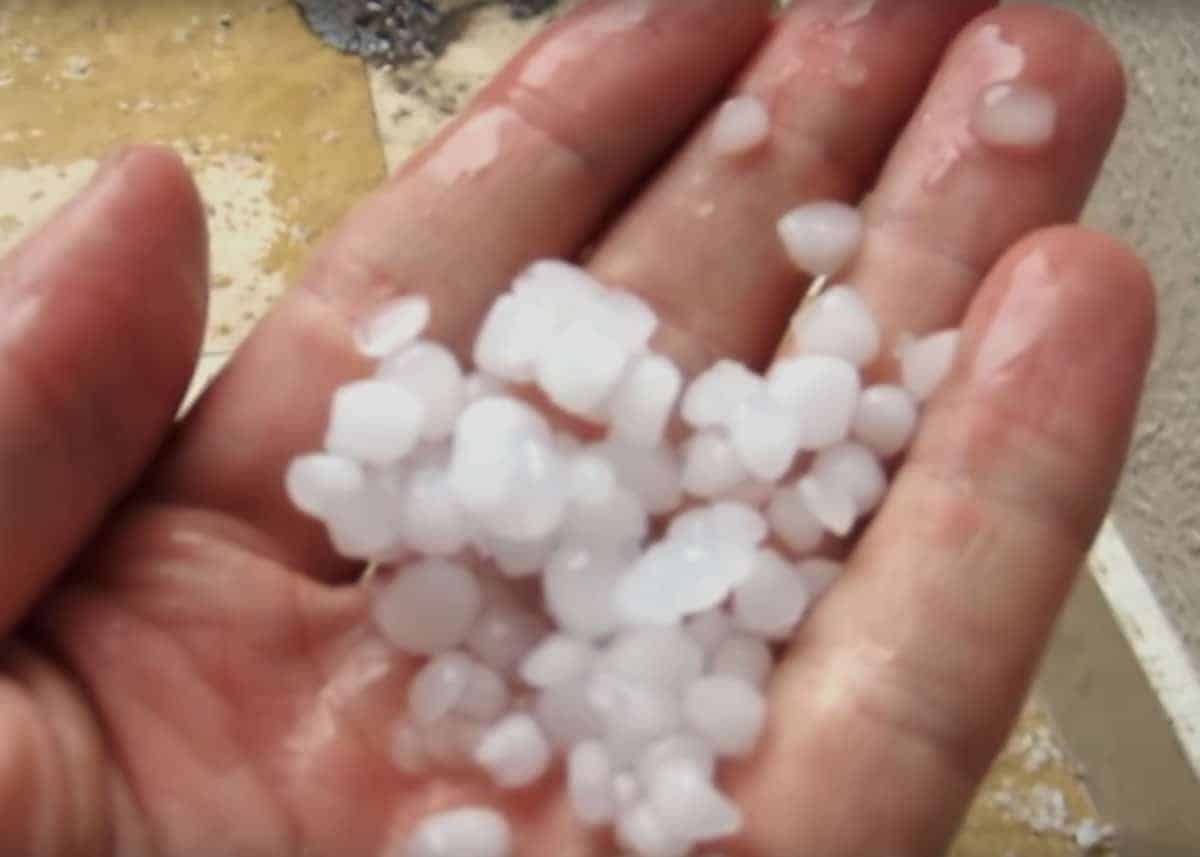


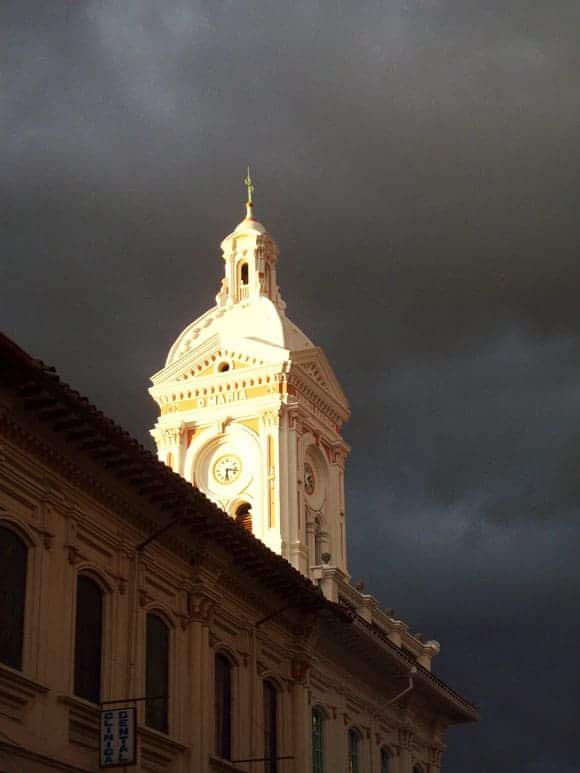


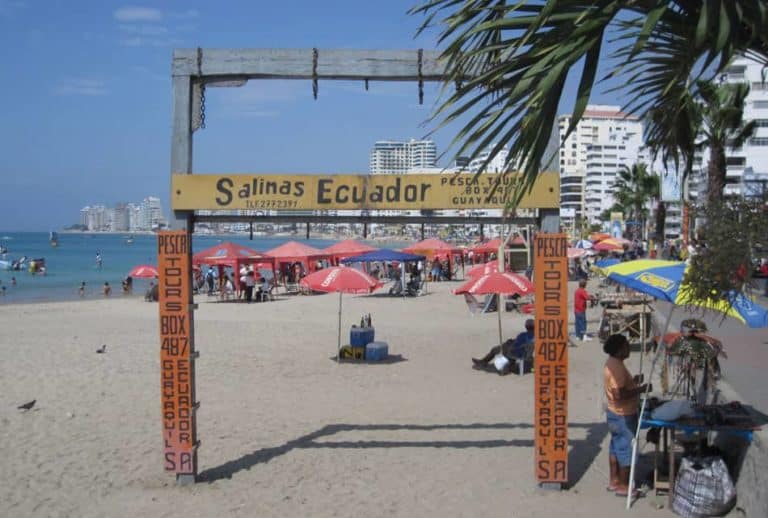
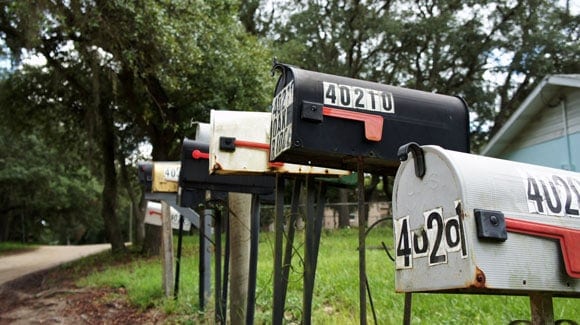
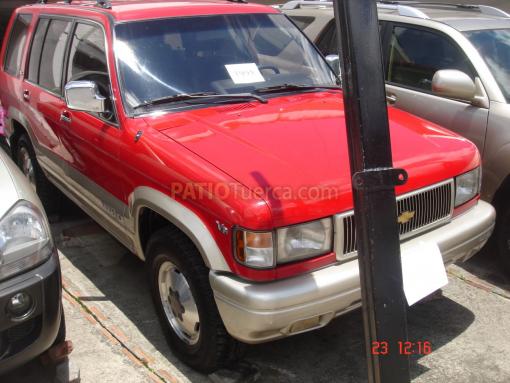

Ive heard loja is called little cuenca. Loja is around elevation of 6500 as opposed to cuenca around 9000. I have heard loja is warmer, maybe 55 to 75. But is it also rainy? Overcast? Unpredictable?
Hey,
I’m Canadian and considered spending winters on the coast of Peru. I checked along Trujillo and noticed the coast may have had earthquake damage? Was that from the last quake? It didn’t look like it’s recovered. The town seemed more reasonable with garbage pick-up and some greenery. Sadly, the poor people are allocated up to the mountains and that would make the activist in me come out. Likely not a wise idea in a foreign country.
I checked Santiago de Cao, a small town just up from Trujillo, but a safety website said that it was unsafe for tourists. I wonder if locals don’t want foreigners or if it’s an accurate assessment.
I spent 2 weeks in Cuenca studying Spanish. The sun peeked out for an hour or so two or three times, otherwise it was overcast. My Spanish teacher, who was born and raised there, said my two weeks were representative of the norm in Cuenca, i.e. drizzle and overcast skies throughout the year. Reports by certain promoters of retirement in Cuenca would seem, to me, to be inaccurate.
Sounds a bit like da Big Island. It tends to be overcast a lot and rains a whole lot. Hilo average rainfall is over 130″ a year. At least it’s not as cold as Cuenca and Oregon or even California. I can’t stand cold weather but to add rain to that makes it worse. At least here on BI it usually warm, can get cold. Actually this last winter was colder then usual. Problem is here houses are not insulated. No heat
Hi Everyone! This is my first time posting here. Long story short — My US father met my Ecuadorian mother after WWII while looking for Inca treasure. My older brother and I were born in Quito. Over the years I’ve been to Ecuador about 6 times. Mostly stayed in Ambato where my Mother lived. I will be relocating to Cuenca near the end of the summer or beginning of fall. I’ve never been there but it’s a university town & cultural center, has my kind of weather (I’m from Seattle, WA but will miss the ocean) and have a pretty good grasp of Ecuadorian Spanish and will continue to perfect it further while there. My question today is, is there up-to-date news of the new laws regarding Permanent Resident Visas and the upcoming Ecuadorian Election April 2? Ecuador considers me an Ecuadorian citizen from birth so I will investigate the possibility of getting both a US passport and an Ecuadorian one. I’ll also be going down to Cuenca to find a place to live before I actually move. Any suggestions about who to contact and use to help facilitate my rental apartment hunting, etc.? Thanks
I took the plunge last year and stayed a month in Cuenca and a month at the coast. They have no heat in most homes in Cuenca because they feel the weather is not cold enough but I was too cold many of the nights and ended up opening the oven and putting some heat into the house I rented. And many days I needed to wear a jacket so for me it was too cold. I guess if you lived there permanently I would install room heaters. The people were lovely and the city nice. We then moved to the coast and stayed in a condo right on the beach. It was beautiful, with walks everyday on the beach. We also met some very nice locals as well as expats while on the coast. My partner was bitten by a sting ray one day and a visit to the local hospital with a shot, cost us nothing. Free health, that was a surprise. We stayed a month in the condo and the electricity and gas cost us $25, another nice surprise. I am a little alarmed that after we left they had some earthquakes along the coast with lots of damage. I liked Ecuador, but think my search is not over. I stayed in Argentina for a few months recently and so far it has my vote, but still want to visit other countries. I am still learning……………..
Where did you stay when you were on the coast? What town? What condo? Was there a Spanish language school nearby?
Thank you!
R
Hi Bryan and Dena, I am really glad to hear you’ll be discussing areas along the coast, soon. I’m originally from New England, but moved to Ft. Lauderdale, Florida, 17 years ago to enjoy the year-round warm tropical weather. I’m retired now, and have spent many hours on the computer researching a possible move to Ecuador. After extensive research, I long-ago decided that I would never be happy with the cooler, cloudy climate of Cuenca, plus I have always lived near the water, and find that to be something essential to my true inner peace and happiness. But all you ever seem to hear about is Cuenca, Cuenca, Cuenca. I’ve read so much about Cuenca, I feel like I’ve already lived there, and shiver at the thought of it. I speak some Spanish and am improving regularly with online tutorials. So it is not necessary for me to live in a “Gringoland” retirement community. I actually want to get to know the locals, and live amongst them. Since I love being near the water, I have for a long time, set my sights on the Bahia/San Vicente area. But since the April, 2016 earthquake, there has been very little current news coming out of that area. Pretty much all the info and pictures available online, are pre-quake, and there is very little available about progress(or lack of progress) in the rebuilding and liveability in those coastal areas. Especially, as regards the realistic current facts that would be of value and interest to potential expats. I hope you will be able to give some current updates on that area, in the near future. I recall that you returned to live in Canada, a while ago, due to medical reasons. Are you now back in Ecuador, or do you possibly have contacts there, who can shed more light on the coastal areas that were affected by the earthquake? Hope all is well with you and your family, and hope you’ll be able to relay some current info about the coastal areas soon. I’m sure there are many other retirees, like myself, who are confirmed “warm weather lovers”, and would welcome current and accurate information about the coastal areas of Ecuador. My sincere thanks, Mark
Hi Mark,
I’m in a similar position as you. I’m considering moving to Ecuador later this year and while Cuenca looks beautiful and definitely worthy of a good visit, I fear it’s going to be too cold and gloomy for me. I currently live in Bali Indonesia. Since posting, have you received much information regarding coastal towns and conditions? I’vd be very interested and grateful to hear what your current thoughts are.
Thank you, Drew
yelapeno@yahoo.com
I lived in Cuenca, Ecuador for 6 months. It was in fact cool to cold and overcast most days… I ultimately returned to the states as I was not able to overcome the parasiticos no matter how careful I was with food and water.
what are the parasiticos, is that from water did you use bottled water
What is the humidity like in Cuenca?
People want to know about the temps. No mention is ever made in info posted about Ecuador weather on the humidity. What are the humidity levels in Cuenca? D. Merz
Average humidity is 64%. Lowest is 31%. Highest is 90%. Mas o menos. That’s pretty humid, but that which affects how we feel, i.e. the comfort zone, are two things: the dew point and the temperature. Not the humidity. And in Cuenca the dew point is usually lower than the temperature. And the temperatures are mild. In other words, the wx is comfortable in Cuenca.
But that’s easy for me to say, sitting here in my EZ chair in Missoula, Montana.
Dew point and relative humidity are directly related – there is no difference for a given pressure.
The pictures of the rain storm are a bit alarming, but I’m fairly certain this sort of storm is not “the norm”, right? (For example, we had a storm where I live – London, Ontario – where the water rose higher than the street curbs, about 4-5 inches, but we only get storms like that maybe once every other year, if that.)
I am hoping to visit Cuenca next year. Is there any time of the year that would be the best to have a true sense of “life in Cuenca”? By this I mean, not just with the weather, but also to experience the culture.
Thank you for your informative posting(s).
No, this isn’t the norm. It happens a few times each year around the city.
Surprised there is no mention of earthquakes which are frequent. See http://earthquaketrack.com/ec-02-cuenca/recent
Most quakes do not cause much damage, but are perceptible -> disturbing depending on how one feels. Big quakes are, however, inevitable near the “ring of fire.”
You’re right that small earthquakes occur in Ecuador. We’ve felt our house move in Cuenca – but there was no damage. When the volcanos are active in the north, tremors (and volcanic ash) can be felt and seen in the far south of the country.
There is a small village south of Cuenca that was destroyed and abandoned decades ago by an earthquake.
Do you have this information yet: climate charts for the top travel/expat areas within the country?
We are considering Ecuador for retirement and are trying to nail down some areas in particular for a trip this year to check out places. Cuenca sounded ideal until we saw the flooding pictures. Plus, reviewers’ comments about chilly mornings/nights have dampened Cuenca’s appeal. We do not want a HOT climate however. We prefer a city/town approx. the size of and conveniences of Cuenca. Plus, good and convenient medical care. Any suggestions?
Thanks for all the info on the weather in Cuenca. I leave in three weeks to live there, based on my research over the past four years. I’m a New Yorker who hates the heat and humidity in the summer, as well as the cold long winters. Of course the cost of living is a major factor, but from what I can tell Cuenca sounds incredible. My biggest concern is the amount of rain. Walking my dogs won’t be fun. But that being said, what do you think of my choice.
Many thanks,
Derek Koonin, NY.
Hi Derek, I’m a New Yorker also exploring the possibility of moving to Cuenca. Are you still living there? How do you like it?
Shuping
Is Quayaguil just a little warmer or is it hot? I am single and I have no intention of owning a car, is $1,250 a month good? Also, is Guayaguil a reasonably safe place?
It is much warmer (hotter) than Cuenca. It can be unbearable (at least for a Canadian like me).
Your budget depends on your lifestyle. Lots of expats live on that amount of money. Guayaquil is reasonably safe – but it depends on what you are comparing it to. It is the opinion of many Ecuadorians that it is the most dangerous city in the country – but it is also the biggest. It could just be an undeserved reputation. I haven’t seen any crime stats by city.
I am 65 yrs. old and labeled disabled. I have my social security income and that is all. I am wondering if it is worth my even considering Ecuador. How can I find out if my medications are obtainable.
To Lyndana, I took a list of meds ands supplements on my recent trip and found that ALL were available, I suspect that your meds will be available unless maybe you are on some new exotic drug. Disabled can be in many different forms but if you are physically disabled and have difficulty getting around then that will be magnified in Cuenca as in most other countries. Many cities in the USA such as here in Houston have tried to mitigate the obstacles a physically disabled person encounters. If you are serious then visit for a couple of weeks and then you will know. The experience of the visit will give you the results and even if Cuenca is not for you it will provide many great memories for you. I can hardly wait until we get our affairs settled here so we can move Must sell this house, cars, get rid of a life time collection of STUFF and secure all financial affairs. Hope to be settled in by Christmas. Weather was spring time every day
Enjoyed the post. People are always asking about weather in Cuenca! Just wanted to point out that there is almost no evidence that the change in weather can cause a person to get sick or catch a cold. This is a long-standing urban myth passed on by mothers each generation. Ecuadorians are particularly stuck on this myth, and it always annoyed me when I heard it. Of course, the changing weather brings people indoors more often, which is what actually makes them sick. I guess, one could argue that the changing weather indirectly makes them more susceptible to contracting illness.
Hi,
Yes, this info is fairly similar to what I was reading in the Lonely Planet guide to Ecuador. It’s also very similar to the weather in Ireland where I lived for 20 years, just south of Dublin. If I ever decide to live there I will probably head for the coast for at least half the year 🙂
Looks to me like a four wheel drive vehicle is de rigueur judging from the photos. Best regards.
Hello Folks. sounds like nice weather, very stable. two night ago it was -20 , today +10c and rain. sunny tomorrow, not sure of the temp. however 15 to 20 cm of snow on Sunday. Spring will so be here. i can start gardening again. i love it . i take great pride in our garden. When we arrive home, i walk to garden before entering the house to make one weed has not sprouted. Have a good evening all three of you. Lou
any place n that country with warmer weather?
You bet! We’ll be covering those in the future – but for now, you should be looking at the coast. Areas like Salinas and Manta.
I can’t wait to hear about the weather in Salinas. We were going to Crucita first when we land in Ecuador, but we have changed our minds and thought we would try Salinas first. We are choosing the coast because of the weather. Have you been to those two cities before or will you be going for the first time to cover it as you mentioned above? If you have visited before, what are you thoughts on each? Thanks
Hi Joyce, we have been to Salinas many times but not to Crucita yet.
Bryan
Is Salinas and Manta hot like Qualaquil. I heard Quayaquil is super hot and humid. Thinking it’s like da weather in Jamaica and Santa Marta, Colombia. The weather is so hot and humid that the nights are still hot. Hard to sleep. I live in Hawaii and though it gets hot in daytime, generally the nights are comfortable. Cuenca soundsto cold for me, not having much sun makes it worse. Is Vilcabamba same type of weather as Cuenca or worse? Mahalo,
How about the Annual Weather Chart for Guayaquil too.
Bryan,I wish we could just sell all assets and fly down,but we do plan to visit,maybe when our winter starts here,Nov,Dec,Jan. I like your e-mail and if I’m lucky my wife and I will get to meet you guys. So many things keep us nailed down here,mainly property assets. Hope to hear from you. Bob
The weather in Cuenca is absolutely gorgeous. I’ve been here since early December and every day has been beautiful, cool in the mornings and evenings and warm during the day, with blue skies. Fortunately it often rains in the afternoons which helps keep the trees and grass green and beautiful.
Thanks for the post. Getting accurate weather forecast in Ecuador is even more challenging than it is in NS, Canada! I use AccuWeather.com for my daily forecast. It is just about as accurate as one can find. It also shows averages, and historical weather, so it was really useful to us when we were deciding what area in the country we wanted to live as far as climate considerations.
Today is Friday 14 Feb 2014, yes, it is Valentine’s Day and the weather is mild. Tuesday night it seemed a bit chilly to me and again last night as well; however it did rain a little bit late yesterday. I am a person who chills easily so for me a light weight jacket is required when the sun goes down. On the ride from Guayaquil to Cuenca through the mountains I was very happy to have a jacket and wished for a bit more than my blue jean jacket.